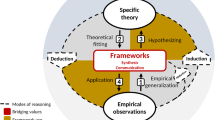Abstract
This article is a reply to Moravcsik's interpretation of my results on Brazilian agricultural research. The argument here is that publication and citation data obtained within a specific country can hardly be compared to those offered by international databases such as that of ISI. Furthermore, publication and citation data must be interpreted in the light of qualitative information if they, are to be of any use for science policy. Finally, the conclusions drawn in my previous paper are reinforced here by the supplying of additional information.
Similar content being viewed by others
References
M. J. MORAVCSOK, In the beholder's eye: a possible reinterpretation of Velho's results on Brazilian agricultural research,Scientometrics, 11 (1987) 000.
L. VELHO, The “meaning” of citation in the context of a scientifically peripheral country,Scientometrics, 9 (1986) 71.
This is the case for example, of the paper by J. D. FRAME, Mainstream research in Latin America and the Caribbean.Interciencia 2 (1977) 143.
F. NARIN, M. P. CARPENTER, National publication and citation comparisons.Journal of the American Society for Information Science, 26 (1975) 80, examined publications and citations in seven major disciplines and six major countries. Agricultural science was not included as major discipline in this study.
Science Indicators 1982. National Science Board, National Science Foundation (1983), p. 203–204.
Data supplied by CENAGRI, the Brazilian National Centre for Information in Agricultural Science.
J. D. FRAME, op. cit. note 3, p. 143, states that “the most significant instance ofSCI undercoverage of a Latin American country appears to be the case of Brazil [...]”.
M. J. MORAVCSIK, personal letter.
A survey conducted by CAPES—Federal Agency for Graduate Education—estimated that there are 900 academic periodicals produced in Brazil. Of these 500 were judged to be of acceptable scientific standards. Yet only two Brazilian journals were used as sources in the 1973 ISI database and only four are listed in the 1981SCI.
M. A. H. CAGNIN, Patterns of research in chemistry in Brazil,Interciencia, 10 (1985) 64.
J. D. FRAME, op. cit. note 3,, p. 144.
M. A. H. CAGNIN, op. cit. note 10, p. 76.
J. BLICKENTAFF M. J. MORAVCSIK, Scientific output in the Third World,Scientometrics, 4(1982) 137.
Actually, M. ROCHE, Y. FREITES, Produccion and flujo de informacion in un pais periferico americano (Venezuela),Interciencia, 7 (1982) 179, report that in the case of Venezuela at least, it is possible to estimate the total number of publications by doubling the figure provided bySCI.
MORAVCSIK does not say for wich year this percentage was calculated. The estimate of Brazilian share in worldwide scientific literature using ISI database is quite imprecise. As an illustration, J. D. FRAME, op. cit. note 3. and E. GARFIELD, Third World research. Part 1.Current Contents, 33 (1983) 5, working with the 1973SCI found very different numbers for the Brazilian output. Whereas Frame found 573 articles authored by Brazilian scientists (0.16% of the total) GARFIELD reports 812 articles (0.23% of the total) of Brazilian origin. This discrepancy is clearly disturbing and significant and illustrates the risks involved in estimating the total number, of Brazilian scientific publications from theSCI. Note that the proportion of the Brazilian contribution to world science found by GARFIELD is 43.75% higher than the one detected by FRAME,using the same database.
J.D. FRAME, F. NARIN, M. P. CARPENTER, The distribution of world science,Social Studies of Science, 7 (1977) 501, for example, have shown that although the scientifically productive nations follow a similar “product mix” with regard to basic science, there is significant variation between them and all the East European countries and many of the Third World countries.
E. GARFIELD, Third World research. Part 2,Current Contents, 34 (1983) 5.
J. D. FRAME, op. cit. note 3,, p. 146.
According toScience Indicators 1982, op. cit. note 5Science Indicators 1982. National Science Board, National Science Foundation (1983), p. 203–204, from 1975 to 1981, about 36% of all doctoral degrees in agriculture and forestry awarded from US universities were to foreign students.
J. BLICKENTAFF M. J. MORAVCSIK, op. cit. note 13..
D. CRANE,Invisible Colleges, Chicago & London, The University, of Chicago Press, 1972.
Published collaboration is considered to be a valid indicator of the existing linkages between individual researchers or groups of scientists. See, for example, D. DE SOLLA PRICE, D. DE BEAVER, Collaboration in an invisible college,American Psychologist, 21 (1966) 1011; D. CRANE, op. cit. note 21. D. CRANE,Invisible Colleges, Chicago & London, The University, of Chicago Press, 1972.
D. EDGE, Quantitative measures of communication in science; A critical review,History of Science, 17 (1979) 111.
Author information
Authors and Affiliations
Rights and permissions
About this article
Cite this article
Velho, L. The author and the beholder: How paradigm commitments can influence the interpretation of research results. Scientometrics 11, 59–70 (1987). https://doi.org/10.1007/BF02016630
Received:
Issue Date:
DOI: https://doi.org/10.1007/BF02016630




